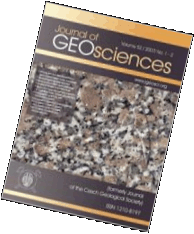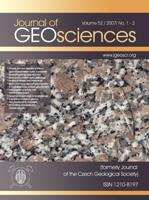 Export to Mendeley
Export to MendeleyOriginal Paper
Pyroxene microgranodiorite dykes from the Sevetin structure, Czech Republic: mineralogical, chemical, and isotopic indication of a possible impact melt origin
Journal of the Czech Geological Society, volume 38 (1993), issue 3-4, 129 - 148
A study of pyroxene microgranodiorite dykes in the Ševětín structure (D = 46 km, deeply eroded) indicates their crystallization from liquids derived from melting mainly of the regionally dominant sillimanite-biotite paragneiss. The microgranodiorite exhibits a rather limited variation of major and trace element contents, except for Mg, Cr, and Ni, that are introduced by a highly magnesian component. Enrichment factors relative to the indigenous concentration in biotite paragneisses are 1.4 to 2.2 for MgO, 1.3 to 5.3 for Ni, 1.2 to 2.8 for Cr, and 0.8 to 1.3 (1.9 ?) for Co; it is likely that most of Pt determined (0.54 to 5.6 ppb) belongs to the Mg-rich component. If the enrichment in these elements were of metoritic origin, then the “net contamination component” is matched only by highly magnesian achondrites (peridotite, enstatite achondrite). Analyses of platinum group elements (PGE) show absence of Ir contamination; Pt/Pd ratio of up to >56, which appears to be unique, indicates a strong fractionation of PGE. Microgranodiorite has major element composition and Sr isotopic composition closely similar to Ries crater suevite and impact glasses in suevite. The Ševětín pyroxene microgranodiorite dykes are free from a signature of partial melting and differentiation that are ubiquitous in the conventional magmatic dyke rocks of the region.
Webdesign inspired by aTeo. Hosted at the server of the Institute of Petrology and Structural Geology, Charles University, Prague.
ISSN: 1803-1943 (online), 1802-6222 (print)
email: jgeosci(at)jgeosci.org


IF (WoS, 2024): 1.3
5 YEAR IF (WoS, 2024): 1.4
Policy: Open Access
ISSN: 1802-6222
E-ISSN: 1803-1943